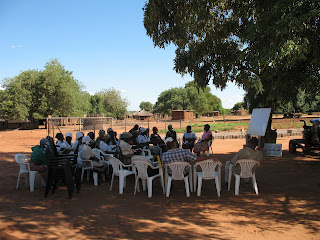
So I got to visit one of the villages that world relief reaches out to this week. Everything that has happened there is extraordinarily interesting. It all started back in the mid-90s when World Relief, a christian international development organization asked all of the village chiefs in the region to recommend one volunteer for each group of 20 families to be trained how to teach basic health practices. The chiefs said their villages were already split into groups of 10 families, so World Relief took one volunteer for every ten families. Volunteers were placed in groups of 10, called care groups. Therefore each care group consists of 10 volunteers and 100 families. Each care group would receive an entire day of training once every 2 weeks by an animator, a local individual trained and paid by World Relief. Each animator would train 8 care groups every 2 weeks (4 days of training per week). There were 26 animators initially that each taught 8 care groups, and so they were over 800 families (100 families per care group). 26 x 800 is 20800 families, and with 6 people in the average family that works out to 124,800 individuals. This organizational structure proved to be incredibly successful in improving health behaviors and decreasing child malnutrition and disease. Subsequently, many other types of programs were instituted along this highly stable and organic organizational backbone. Specific examples include TB recognition and treatment and agricultural development.
And all that is to say I traveled to a village about 50 km from what could be called a very small town and 100 km from the town where I am staying. This village had been chosen for a pilot agricultural development program that first utilized only the volunteers from the health education program and then was opened up to any volunteers from the community. The agricultural program involves the group of individuals actively paying for the diesel water pump and and microdrip irrigation that was initially provided with funds from World Relief and a church in the US that partnered specifically with that community. Effectively, the individuals each own the land that they are working as well as the technology employed to improve the crop output. And it is working, despite the rumor mill and backstabbing that happens in any organization/business, despite the fact that the program is comprised of a wide cross-section of the community, not just one religious group, and it is going to get some serious recognition tomorrow for it. The First Lady of the country (the president's wife) is going to visit the village for a couple days and they will be on national television. With thousands of villages in the country, this is a huge honor.
Unfortunately, I won't be able to go, she is there to see Mozambicans, not a foreign, doesn't even know what he wanna-be like me. But it's still pretty cool to kind of be a part of it. It's been tough though to be excited about all this, cuz my hours of studying portuguese have proven relatively unhelpful. Even though a large percentage of the people in th area speak some portuguese, all the day-to-day everything is done in tsonga and i know about 10 words of it. so i can speak to people one-on-one whenever i get the rare chance but i have no idea what's going on when i'm "part of a conversation". All that to say i'll appreciate any personal contact from anyone who has the chance.
peace and love
Hi Ross,
ReplyDeleteI just got some info about a position with World Relief on their project in Mucatine and found your blog when I googled the name. How perfect! Thanks for writing this.
I have lots of questions about the country/area/culture, etc and would like to ask if I could get your perspective on some things. Would you entertain some questions for me if I sent them to you? I might have to make a decision soon! My e-mail is below.
Best,
Kendra
Kendra.Levine@gmail.com